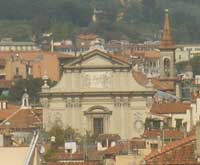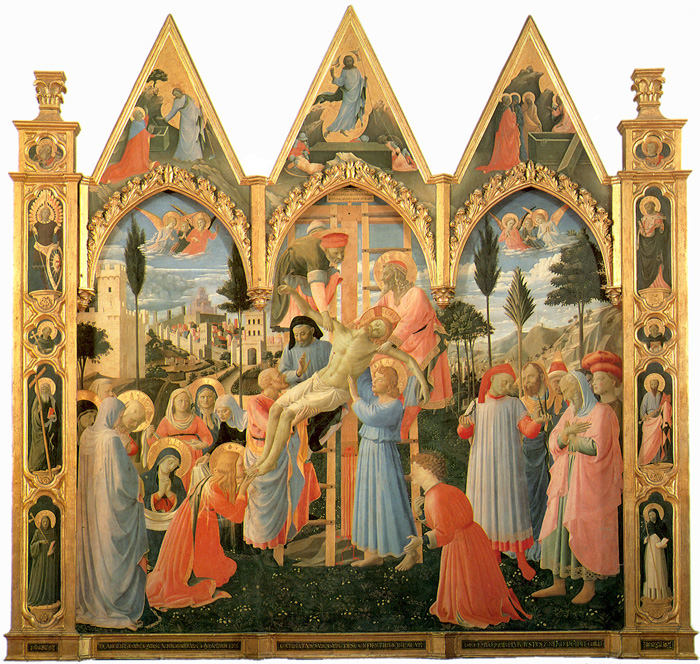 |
|
Fra Angelico, Deposition from the Cross (Pala di Santa Trinità), 1437-40, tempera on panel, 176 x 185 cm, Museo di San Marco, Florence |
|
Fra Angelico | Deposition from the Cross (Pala di Santa Trinità), 1432-1434 |
| The Deposition from the Cross is a painting executed by Fra Angelico between 1432 and 1434. It is now housed in the National Museum of San Marco, Florence. Fra Angelico intervened to complete this altarpiece when it had been already begun by Lorenzo Monaco for the Strozzi Chapel in the Florentine church of Santa Trinita. It portrays Christ supported by several people, with Mary Magdalene keeping his feet, as a symbol of human repention. A figure on the right, with a red hat, is showing the cross' nails and the horns crown, symbols of passion and sacrifice. Mary, wearing a dark dress, is showed in the traditional gesture of keeping hands joined.
|
| The Deposition from the Cross was originally commissioned by Palla Strozzi from Lorenzo Monaco, for the sacristy of the church of Santa Trinità in Florence, but by the time of Monaco's death only the pinnacles of this work had been painted. When Angelico took over the commission he found himself cribbed and confined by Monaco's ready-made triple-arched Gothic frame. He ignored these constraints, however, making skilful use of the three arches in his composition to provide a scene of stunning beauty and subdued yet poignant emotion, set in an expansive Tuscan landscape. Although the work is painted on one panel, the three arches of the frame find an echo in the placing of the figures in three groups. The central arch is largely blocked off by the wooden framework of the cross and two ladders. The cross bar of the former appears to run behind the picture frame hinting at further, obscured space. With no scene behind but the sky and the lattice work of timber, the eye is drawn to the body of Christ which is at the very centre of the picture. Angelico challenges the tendency of the other two arches to define the shape and space of the work by placing a strong vertical, in the form of a tower or a tree, in the corners of each. The pilasters on either side of the frame contain twelve panels with full length portraits of saints, and eight medallions with portrait busts. The full-length figures are shown standing on columns which are each painted with careful attention to the view-point of the spectator. |
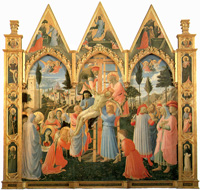 |
|
| The cross has no upper limb, thereby blunting the pointedness of the arch behind which it stands. There is room at the top only for a view of the mocking panel which declares Christ King of the Jews. Christ is covered with the weals of the flagellation, and blood trickles from the lance wound in his side. More blood runs down the cross to the rock at the base, a stylized representation of Golgotha. Christ's head lies almost horizontally, his passive face marked only by thin dribbles of blood from the pricks of the crown of thorns. Vasari claims that one of the figures lowering Christ is a portrait of Michelozzo, the architect responsible for the rebuilding of the convent of San Marco in Florence. Pope-Hennessy suggests that if he is represented at all it is in the figure under Christ's right arm wearing a black cappucio, or monastic hood. In the distance at the top left lies Jerusalem, shown by Angelico as a sparkling Tuscan hill town. The city fortifications appear as a series of cubes, pillars, and walls massed together in a sharply defining light. Buildings of widely varying sizes, shapes and colours are arranged together within the city walls. At the top of the hill rises a citadel-like temple. Outside the city gates lies a landscape of ploughed fields, farmhouses, and hedgerows. In the sky, above a storm cloud is gathering which throws shadow over half the city. The whole is viewed through a screen of trees, which mark out the middle distance in the complete picture. Fra Angelico's Deposition demonstrates not only his skillful treatment of landscapes, but also figures, to which he often gave specific and presumably identifiable features. The man in the turban is likely a portrait of a person known to the artist. |
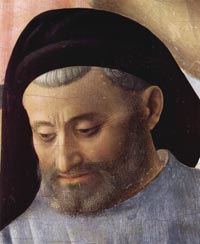 |
|
| Fra Angelico stops short of portraying the figures lamenting Christ's death in the agonies of grief; instead he shows them in languorous contemplation of their inner sorrow. Mary Magdalen kneels before Christ, taking his feet in her hands and kissing them. The Virgin kneels, her hands clasped, head on one side in reflective misery, with an air of particular detachment. She is partly screened from the viewer by the winding sheet held before her. The other holy women stand in positions of contemplation or prayer; one wipes a tear from her eye. As in earlier paintings by Angelico, the sense of the space in which the Virgin kneels is created by placing figures in a circle around her. In the background the road begins to wind its way up to Jerusalem. |
||
| Kneeling in the foreground of the picture is a Beato. He echoes the Magdalen in his position, pose and red gown. A foreshortened arm extends out towards the viewer, drawing us into the scene before us. It has been suggested that this figure is Alessio degli Strozzi, the dead son of the family whose patronage brought about the creation of the work. Behind him are five men, standing further forward in the picture plane than the women on the other side whom they balance. Like the women each is contemplative, reticent and mournful. One displays to the others some of the instruments of crucifixion: three gruesomely large nails with heavy drips of blood on them, and the neatly woven circlet of thorns whose perforations can be seen on Christ's brow. Beneath their feet, indicative of Angelico's enjoyment of the portrayal of nature, is the richly leafed and flowered turf which is common to so many of his paintings. |
||
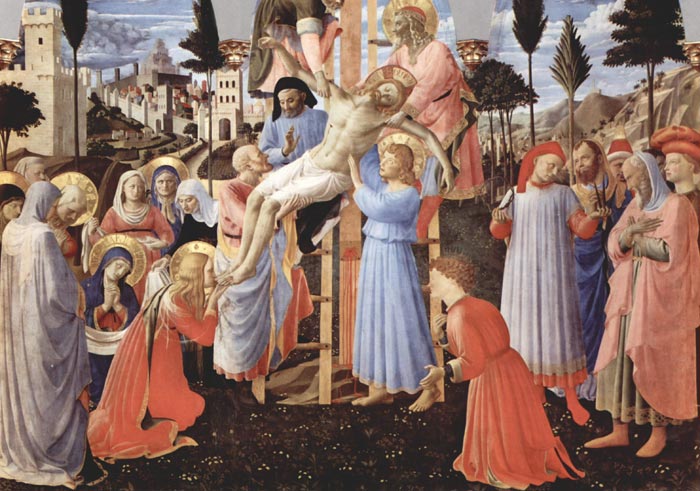 |
||
Fra Angelico, Deposition from the Cross (detail), 1437-40, tempera on panel, 176 x 185 cm, Museo di San Marco, Florence |
||
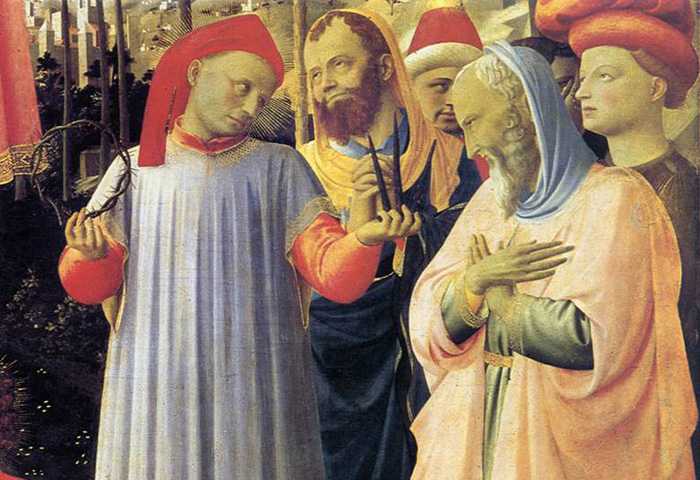 |
||
Fra Angelico, (Pala di Santa Trinità detail , 1437-40, tempera on panel, 176 x 185 cm, Museo di San Marco, Florence |
||
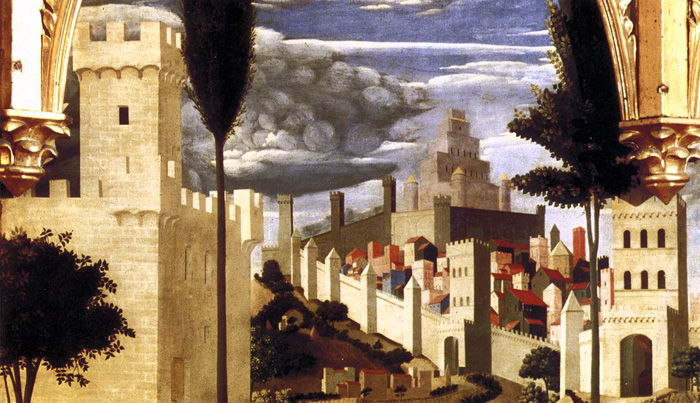 |
||
Fra Angelico, Deposition from the Cross (detail, city) , 1437-40, tempera on panel, 176 x 185 cm, Museo di San Marco, Florence |
||
In this detail the towered buildings confirm the landscape as Italian. The hills stretch out into the distance, softened and smoothed by the light, peppered with gleaming villages and farmhouses. The foreground rocks are insufficiently distant to be mellowed, and are shown with all their facets and angularity. A row of trees again screens the landscape, emphasizing its distance. |
||
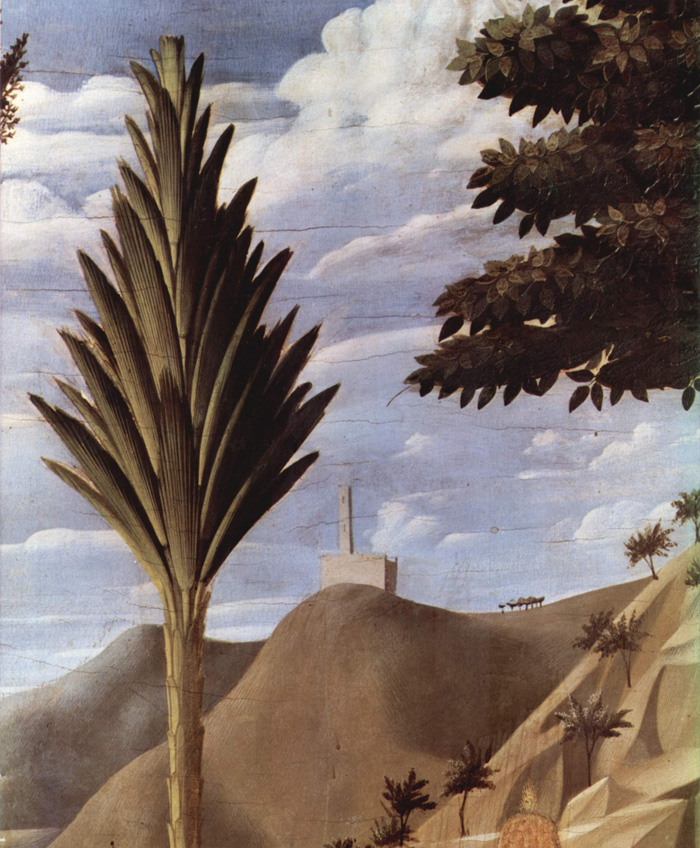 |
||
Fra Angelico, Deposition from the Cross (detail, landscape), 1437-40, tempera on panel, 176 x 185 cm, Museo di San Marco, Florence |
||
San Marco Museum (Italian) | www.polomuseale.firenze.it Encyclopedia Britannica complete article on Fra Angelico | The full version of the article is available if you follow this link. 'Fra Angelicos great Deposition is by no means a straightforward recitation of the biblical narrative. At the center, Joseph of Arimathaea, Nicodemus, and the young Saint John the Evangelist, all haloes, lower the lifeless body of Christ. Two unidentified gentlemen, sometimes considered portraits, also participate. At far left Fra Angelico has depicted the many women who had followed the Via Crucis procession from Jerusalem, including the three Maries. Two other holy women in this group who have halos have never been identified. There are no textual of pictorial precedents for the group of worshipers, at right, who contemplate the event and sagely discuss the crown of thorns and the three nails. The young man kneeling in the foreground is believed to represent the Blessed Alessio degli Strozzi, a holy ancestor of Palla Strozzi, the humanist who commissioned this altarpiece for the sacristy of Santa Trinita.' John Spike, Fra Angelico, Abbeville Press, New York, 1997. Giorgio Vasari | Lives of the Most Eminent Painters Sculptors and Architects, Fra Angelico | Detailed biography of the artist |
||
Fra Angelico was born Guido di Pietro, at Vicchio, in the Tuscan province of Mugello, near Florence towards the end of the 14th century, of unknown but seemingly well-to-do parentage, and was baptized Guido or Guidolino (friars use to change their name when entering the orders). Still a young boy he asked for admittance at the convent of San Domenico in Fiesole, where Dominican friars were known for their rigid rules (and were called "the Observers"). He completed his novitiate in Cortona in 1408 and became a real Dominican monk in Fiesole about 1418 with the name of "Fra Giovanni da Fiesole"; "The Angelic" is a laudatory term which was assigned to him at an early date,—we find it in use within thirty years after his death; and, at some period which is not defined in our authorities, he was beatified by due ecclesiastical process. Whether he had previously been a painter by profession is not certain, but may be pronounced probable. The painter named Lorenzo Monaco may have contributed to his art-training, and the influence of the Sienese school is discernible in his work. He had several important charges in the convents he lived in, but this didn't limit his art, that very soon became famous. He had the patronage of Cosimo de' Medici. According to Vasari, the first paintings of this artist were in the Certosa of Florence; none such exist there now. Among his early works, the Annunciation of Cortona, the Incoronation of the Blessed Virgin Mary (in the convent of Fiesole); the Deposition of Christ executed for the church of the Holy Trinity in Florence, paintings that Vasari indicated as "painted by a saint or an angel". His earliest extant performances, in considerable number, are at Cortona, whither he was sent during his novitiate, and here apparently he spent all the opening years of his monastic life. His first works executed in fresco were probably those, now destroyed, which he painted in the convent of S. Domenico in this city; as a fresco-painter, he may have worked under, or as a follower of, Gherardo Starnina. From 1418 to 1436 he was back at Fiesole; in 1436 he was transferred to the Dominican convent of S. Marco in Florence. In the convent of San Marco, in the years 1438-1445, Fra Giovanni lived with St. Antoninus Pierozzi. Here he decorated the cells, the hall of the Chapter, the corridors, the colonnade, the church altarpiece; he may have studied about this time the renowned frescoes in the Brancacci chapel in the Florentine church of the Carmine and also the paintings of Orcagna. In 1445, after the success of these works he was invited by the pope to Rome. The pope who reigned from 1431 to 1447 was Eugenius IV., and he it was who in 1445 appointed another Dominican friar, a colleague of Angelico, to be archbishop of Florence. If the story (first told by Vasari) is true—that this appointment was made at the suggestion of Angelico only after the archbishopric had been offered to himself, and by him declined on the ground of his inaptitude for so elevated and responsible a station—Eugenius, and not (as stated by Vasari) his successor Nicholas V., must have been the pope who sent the invitation and made the offer to Fra Giovanni, for Nicholas only succeeded in 1447. The whole statement lacks authentication, though in itself credible enough. Certain it is that Angelico was staying in Rome in the first half of 1447; and he painted in the Vatican the Cappella del Sacramento, which was afterwards demolished by Paul III. In June 1447 he proceeded to Orvieto, to paint in the Cappella Nuova of the cathedral, with the co-operation of his pupil Benozzo Gozzoli. In 1450, Fra Angelico became Prior of the convent of San Marco and later Archbishop of Florence. He afterwards returned to Rome to paint the chapel of Nicholas V. In this capital he died in 1455, and he lies buried in the church of the Minerva. He decorated many of the rooms of the Dominican convent of San Marco in Florence, including many of the individual cells. He used to say "He who does Christ's work must stay with Christ always". This motto granted the epithet "Blessed Angelico", "because of the perfect integrity of his life and the almost divine beauty of the images he painted, to a superlative extent those of the Blessed Virgin Mary (Pope John Paul II, 1982)". According to all the accounts which have reached us, few men on whom the distinction of beatification has been conferred could have deserved it more nobly than Fra Giovanni. He led a holy and self-denying life, shunning all advancement, and was a brother to the poor; no man ever saw him angered. He painted with unceasing diligence, treating none but sacred subjects; he never retouched or altered his work, probably with a religious feeling that such as divine providence allowed the thing to come, such it should remain. He was wont to say that he who illustrates the acts of Christ should be with Christ. It is averred that he never handled a brush without fervent prayer and he wept when he painted a Crucifixion. The Last Judgment and the Annunciation were two of the subjects he most frequently treated. Bearing in mind the details already given as to the dates of Fra Giovanni's sojournings in various localities, the reader will be able to trace approximately the sequence of the works which we now proceed to name as among his most important productions. In Florence, in the convent of S. Marco (now converted into a national museum), a series of frescoes, beginning towards 1443; in the first cloister is the Crucifixion with St. Dominic kneeling; and the same treatment recurs on a wall near the dormitory; in the chapterhouse is a third Crucifixion, with the Virgin swooning, a composition of twenty life-sized figures—the red background, which has a strange and harsh effect, is the misdoing of some restorer; an "Annunciation," the figures of about three-fourths of life-size, in a dormitory; in the adjoining passage, the "Virgin enthroned," with four saints; on the wall of a cell, the "Coronation of the Virgin," with Saints Paul, Thomas Aquinas, Benedict, Dominic, Francis and Peter Martyr; two Dominicans welcoming Jesus, habited as a pilgrim; an "Adoration of the Magi"; the "Marys at the Sepulchre." All these works are later than the altarpiece which Angelico painted (as before mentioned) for the choir connected with this convent, and which is now in the academy of Florence; it represents the Virgin with Saints Cosmas and Damian (the patrons of the Medici family), Dominic, Peter, Francis, Mark, John Evangelist and Stephen; the pediment illustrated the lives of Cosmas and Damian, but it has long been severed from the main subject. In the Uffizi gallery, an altarpiece, the Virgin (life-sized) enthroned, with the Infant and twelve angels. In S. Domenico, Fiesole, a few frescoes, less fine than those in S. Marco; also an altarpiece in tempera of the Virgin and Child between Saints Peter, Thomas Aquinas, Dominic and Peter Martyr, now much destroyed. The subject which originally formed the predella of this picture has, since 1860, been in the National Gallery, London, and worthily represents there the hand of the saintly painter. The subject is a Glory, Christ with the banner of the Resurrection, and a multitude of saints, including, at the extremities, the saints or beati of the Dominican order; here are no fewer than 266 figures or portions of figures, many of them having names inscribed. This predella was highly lauded by Vasari; still more highly another picture which used to form an altarpiece in Fiesole, and which now obtains world-wide celebrity in the Louvre—the "Coronation of the Virgin," with eight predella subjects of the miracles of St. Dominic. For the church of Santa Trinita, Florence, Angelico executed a "Deposition from the Cross," and for the church of the Angeli, a "Last Judgment," both now in the Florentine academy; for S. Maria Novella, a "Coronation of the Virgin," with a predella in three sections, now in the Uffizi,—this again is one of his masterpieces. In Orvieto cathedral he painted three triangular divisions of the ceiling, portraying respectively Christ in a glory of angels, sixteen saints and prophets, and the virgin and apostles: all these are now much repainted and damaged. In Rome, in the Chapel of Nicholas V., the acts of Saints Stephen and Lawrence; also various figures of saints, and on the ceiling the four evangelists. These works of the painter's advanced age, which have suffered somewhat from restorations, show vigour superior to that of his youth, along with a more adequate treatment of the architectural perspectives. Naturally, there are a number of works currently attributed to Angelico, but not really his; for instance, a "St Thomas with the Madonna's girdle," in the Lateran museum, and a "Virgin enthroned," in the church of S. Girolamo, Fiesole. It has often been said that he commenced and frequently practised as an illuminator; this is dubious and a presumption arises that illuminations executed by Giovanni's brother, Benedetto, also a Dominican, who died in 1448, have been ascribed to the more famous artist. Benedetto may perhaps have assisted Giovanni in the frescoes at S. Marco, but nothing of the kind is distinctly traceable. A folio series of engravings from these paintings was published in Florence, in 1852. Along with Gozzoli already mentioned, Zanobi Strozzi and Gentile da Fabriano are named as pupils of the Beato. We have spoken of Angelico's art as "pietistic"; this is in fact its predominant character. His visages have an air of rapt suavity, devotional fervency and beaming esoteric consciousness, which is intensely attractive to some minds and realizes beyond rivalry a particular ideal—that of ecclesiastical saintliness and detachment from secular fret and turmoil. It should not be denied that he did not always escape the pitfalls of such a method of treatment, the faces becoming sleek and prim, with a smirk of sexless religiosity which hardly eludes the artificial or even the hypocritical; on other minds, therefore, and these some of the most masculine and resolute, he produces little genuine impression. After allowing for this, Angelico should nevertheless be accepted beyond cavil as an exalted typical painter according to his own range of conceptions, consonant with his monastic calling, unsullied purity of life and exceeding devoutness. Exquisite as he is in his special mode of execution, he undoubtedly falls far short, not only of his great naturalist contemporaries such as Masaccio and Lippo Lippi, but even of so distant a precursor as Giotto, in all that pertains to bold or life-like invention of a subject or the realization of ordinary appearances, expressions and actions—the facts of nature, as distinguished from the aspirations or contemplations of the spirit. Technically speaking, he had much finish and harmony of composition and colour, without corresponding mastery of light and shade, and his knowledge of the human frame was restricted. The brilliancy and fair light scale of his tints is constantly remarkable, combined with a free use of gilding; this conduces materially to that celestial character which so pre-eminently distinguishes his pictured visions of the divine persons, the hierarchy of heaven and the glory of the redeemed. |
||
|
|
||||
|
||||
Podere Santa Pia, mystic holiday home in the heart of the Tuscan Maremma
|
Casa Vacanze Podere Santa Pia, Castiglioncello Bandini, Toscane
|
Colline sotto Podere Santa Pia con ampia vista sulla Maremma Grossetana
|
||
| |
|
|||
Pools in a natural area, a dive into the heart of Tuscany
|
A beautiful spring morning by the pool, a natural jewel nestled amidst the verdant Tuscan hill
|
The night pool at Podere Santa Pia exudes a hypnotic sense of purity
|
||
Fra Angelico in Palazzo Strozzi en Museo San Marco
The exhibition Beato Angelico at Palazzo Strozzi and the Museo San Marco explores the work, development, and influence of Beato Angelico's art, as well as his relationships with painters such as Lorenzo Monaco, Masaccio, Filippo Lippi, and sculptors like Lorenzo Ghiberti, Michelozzo, and Luca della Robbia. It is the first major exhibition in Florence dedicated to the artist exactly seventy years after the 1955 monograph. |
||||
| |
||||
Beato Angelico, la grande mostra a Palazzo Strozzi, sala 1, Santa Trinità [Beato Angelico e Lorenzo Monaco, Deposizione dalla Croce, 1432-1434, tempera su tavola, 176×185 cm, Museo Nazionale di San Marco di Firenze, Firenze] [Photo: Ela Bialkowska, OKNO Studio]
|
||||
 |
|
 |
||
Palazzo Strozzi, Firenze
|
Beato Angelico, mostra Palazzo Strozzi and Museo di San Marco, Firenze, 2025
|
Museo di San Marco, veduta posteriore
|
||
Beato Angelico, la grande mostra a Palazzo Strozzi, Firenze, sala 1
|
Beato Angelico, Pala della compagnia di San Francesco in Santa Croce (1428-1429) e Giudizio universale (1425-1428 circa), Museo di San Marco, Firenze
|
Beato Angelico, panoramica della mostra con la Pala d'altare di San Marco ( 1438-1442) e la Pala di Annalena (1445 circa), Palazzo Strozzi, Firenze, 2025
|
||
Museo di San Marco |
||||
The San Marco Museum occupies the oldest part of a Dominican monastery rebuilt by Michelozzo during the decade from 1436 to 1446 by appointment of Cosimo de' Medici the Elder. Museo di San Marco Monday-Friday: 8.15-13.50; Saturday: 8.15-18.50; Sunday: 8.15-19.00 |
||||
| This article incorporates material from the Wikipedia article Deposition of Christ (Fra Angelico) published under the GNU Free Documentation License. |
||||

